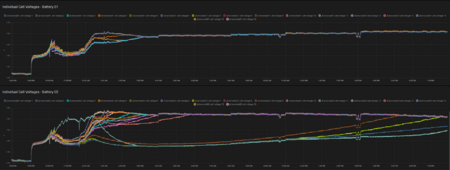silverstone
Solar Enthusiast
- Joined
- May 3, 2022
- Messages
- 1,041
I got the system up and running approx. September 2023. Still a work in progress, but I have 2 x 1p16s batteries (in parallel) with JK BMS.
Deye is working in Voltage Control Mode for the Battery. IIRC on the Deye I set Float to 54.2VDC, Absorbtion to 55.0VDC and Equalization to 55.0VDC.
I have also a charger connected to the Batteries (in parallel), which I can control remotely using CANbus.
However, I noticed especially yesterday-today, when I am forcing a "top off" balance of all cells and leaving the pack voltage ABOVE Float/Absorbtion/Equalitation, today I have 56.0-56.1 VDC, that ALL the PV power gets completely ignored. I am doing this to force the cells to properly balance, as my second battery was all over the place:

I am using the Deye in "off-grid" mode (Load/Backup port only), and what I observe is that instead of taking PV power -> Load, what happens instead is Grid Power -> Charger -> Battery -> Inverter -> Load. Thus a lot of losses which I typically spare (if there is sun and I'm below Float/Absorbtion/Equalitation Voltage).
I'm not sure if the Deye is thinking ... "Battery is Overvoltage, I should discharge it" or what is going on exactly ...
At some point I was planning on using an ESP32 with https://github.com/klatremis/esphome-for-deye to control the Deye Voltage. But I don't think it's too good to keep changing the voltages settings, as this will IMHO wear out the flash memory of the Deye potentially very quickly.
Anybody experiencing something similar ? Is this a bug that was fixed in a later firmware update ? Or is this a "feature" ?
Deye is working in Voltage Control Mode for the Battery. IIRC on the Deye I set Float to 54.2VDC, Absorbtion to 55.0VDC and Equalization to 55.0VDC.
I have also a charger connected to the Batteries (in parallel), which I can control remotely using CANbus.
However, I noticed especially yesterday-today, when I am forcing a "top off" balance of all cells and leaving the pack voltage ABOVE Float/Absorbtion/Equalitation, today I have 56.0-56.1 VDC, that ALL the PV power gets completely ignored. I am doing this to force the cells to properly balance, as my second battery was all over the place:

I am using the Deye in "off-grid" mode (Load/Backup port only), and what I observe is that instead of taking PV power -> Load, what happens instead is Grid Power -> Charger -> Battery -> Inverter -> Load. Thus a lot of losses which I typically spare (if there is sun and I'm below Float/Absorbtion/Equalitation Voltage).
I'm not sure if the Deye is thinking ... "Battery is Overvoltage, I should discharge it" or what is going on exactly ...
At some point I was planning on using an ESP32 with https://github.com/klatremis/esphome-for-deye to control the Deye Voltage. But I don't think it's too good to keep changing the voltages settings, as this will IMHO wear out the flash memory of the Deye potentially very quickly.
Anybody experiencing something similar ? Is this a bug that was fixed in a later firmware update ? Or is this a "feature" ?


